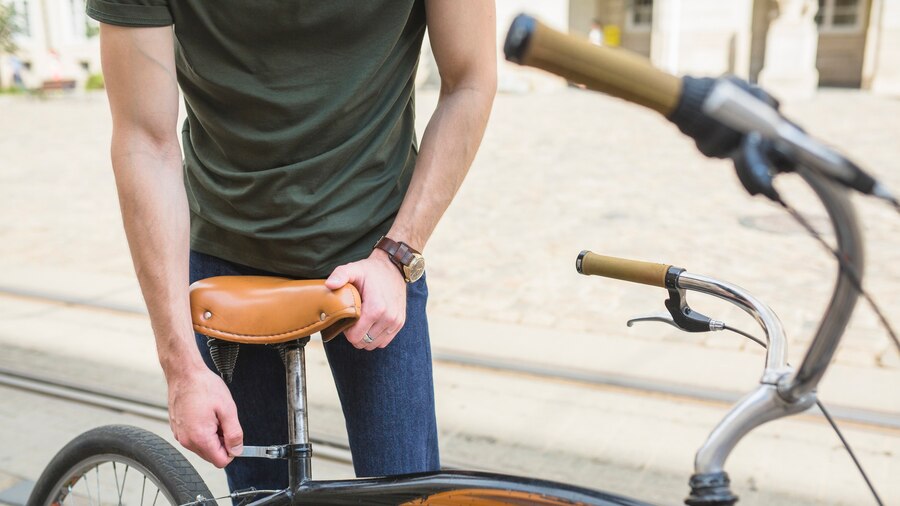The perfect seating position is essential for enjoying a bike ride, whether it is a quick ride or a long-distance trip. For this reason, you must learn how to adjust bike seat to fully enjoy your ride.
Poor positioning of bike seats can cause discomfort, pain, and potential injuries. Therefore, it is important to ensure that the contact points between you and your bike are properly adjusted to fit your physique and feel comfortable.
This detailed guide will discuss how to adjust bike saddle height, angle, and position. Let’s look at a few techniques for adjusting your bike saddle to achieve maximum comfort and joy.
Tools Required to Adjust Bike Seat
- Allen wrench set
- Adjustable wrench or spanner
- Bike multi-tool
- Level
- Tape measure
- Grease or lubricant
- Work stand (optional)
How to Adjust Bike Seat Height?
The three most common and widely used methods for adjusting bike saddle height among bikers are the Heel, Hamley, and Holmes’ Methods. These approaches offer practical and reliable methods for determining the ideal seat height for comfortable and efficient cycling.

Here’s a comprehensive step-by-step guide:
Heel Method
- Put on your cycling shoes and place your feet on the pedals with the heels of your feet.
- Rotate the pedals so that one is at its lowest point.
- Sit on the saddle and stretch your leg until your heel lands on the pedal. Your leg should be nearly fully extended, with only a small bend in the knee.
- The seat height is correct if your heel barely touches the pedal. It is excessively high if your leg is entirely extended. The saddle is too low if your heel cannot touch the pedal.
- Adjust as needed by loosening the seat post clamp, lifting or lowering the saddle, and then firmly tightening the clamp.
Hamley Method
- Sit on your bike, heels on the pedals.
- Turn the pedals down.
- Your legs should be completely extended with your knees slightly bent. The saddle is too high if your heels cannot reach the pedals. The seat is too low if your knees are overly bent.
- Adjust the saddle height as needed, then recheck until your legs are comfortably extended.
Holmes Method
- Put your bike against a wall or have a friend hold you upright.
- Position your heel on the lowest point of the pedal.
- Make sure your leg is fully stretched without your hips tilting.
- Straighten, but do not lock your knee.
- Adjust the saddle height to get the ideal leg extension.
- Ride your bicycle and make any necessary modifications.
Using these approaches guarantees that your saddle height is in sync with your body’s mechanics, which reduces strain and improves riding efficiency.
How to Adjust Seat Placement Angle?
Your seat angle should be horizontal, but you might want to experiment with it. Women like to have their saddle’s nose pointing a little downward, whilst men prefer to have their nose pointing slightly up. Below is a step-by-step tutorial to properly adjusting the angle of your bike saddle:
Loosen Seat Clamp
The seat clamp can be found beneath or at the saddle post junction. To loosen the clamp without completely removing it, use the appropriate instrument, commonly an Allen wrench.

Determine Current Angle
Sit in your typical riding position and check the seat angle. Determine whether the current angle is comfortable or if changes are required.
Tilt seat
Lift the front or back of the saddle slightly while maintaining the seat clamp loose to tilt the saddle forward or backward. Determine the best angle for your riding style and physique.
Test & Modify
Take a short test ride to evaluate the adjusted seat angle’s comfort and stability. Take note of how your weight is distributed and how you pedal.
Fix Seat Clamp
Once you’ve determined the best angle, secure the saddle clamp. During your rides, make sure the saddle is stable and does not move.

Think About Biomechanics
Consider your comfort and biomechanics. A slightly slanted saddle can relieve pressure on sensitive areas while also increasing pedaling efficiency.
Record Your Setting
When you’re satisfied with the angle adjustment, mark the seat post with a permanent marker or take a photo.
A properly adjusted saddle angle leads to less discomfort, improved power transmission, and greater enjoyment while cycling.
How to Adjust Bike Seat Forward & Backward?
Adjusting the horizontal position of your bike saddle properly is critical for achieving maximum comfort and efficiency during rides. Following is a detailed guide to adjusting the forward and backward placement of your bike saddle:
Find Seat Clamp
Determine whether the seat clamp is beneath or at the saddle post junction. To modify it, you’ll need a proper tool, like an Allen wrench.
Unscrew Clamp
Loosen the seat clamp without completely removing it. This allows you to move the saddle forward and back along the saddle rails.

Evaluate Your Position
Sit in your typical riding position and paddle a few times. Examine how your hips and knees align with the pedals. Determine whether the existing seat position is comfortable or if adjustments are required.
Slide Seat
Lift the nose of the saddle slightly and slide it along the rails in the correct direction to move the saddle forward. Lift the tail of the saddle and adjust accordingly to move it backward.
Maintain Balance
Ensure that the saddle remains level during the adjusting process. A level saddle reduces pressure on particular points and encourages proper weight distribution.
Test & Modify
Take a quick ride to assess the adjusted seat position’s comfort and pedaling behaviors. Take note of how your body interacts with the pedals and handlebars.
Fasten Clamp
Once you’ve determined the ideal saddle position, tighten the seat clamp securely. During rides, make sure the saddle is stable and does not slide.

Record Setting
Consider marking the saddle post with a permanent marker or taking a photo to remember your preferred position. It will allow you to keep the same adjustments for future modifications or changes.
You can ensure a comfortable and efficient riding experience by routinely checking and fine-tuning the horizontal position of your bike seat.
How to Know If Your Saddle Height Is Correct?
You can assess that your saddle height is optimal for a comfortable and effective cycling experience by considering the following factors:
- Legs should have a slight bend in the knee but be nearly completely stretched at the bottom of the pedal stroke.
- Maintain a controlled, small bend in the knee at the bottom of the stroke while pedaling.
- A properly set seat height facilitates effective power transfer and comfortable pedaling.
- The proper saddle height reduces muscle strain, enabling smooth and efficient pedal strokes.
- Take short rides to get an idea of your overall comfort and balance.
What Are the Consequences of Improper Bike Seat Height?
Too High Bicycle Seat
- A high saddle forces your legs to overextend at the bottom of the pedal stroke, which can result in strained muscles and decreased power.
- Excessive knee extension may cause pain in the knee cap over time.
- As a result of the high seat, your hips may bounce side to side, generating instability and reducing your ability to retain control.
- Excessive leg extension affects efficient pedaling dynamics, making it difficult to maintain a smooth and regular rhythm.
- Such a saddle might cause lower back pain and pressure points on your hands and feet.

Too Low Bicycle Seat
- A low saddle might cause excessive knee bend at the bottom of the pedal stroke, which reduces power transfer and slows movement.
- Insufficient leg extension may strain your knee joints, causing discomfort, pain, and long-term injury.
- Your ability to generate power is reduced, making climbing and sprinting more difficult and unsuccessful.
- Due to the abnormal position and increased pressure, a low seat can create discomfort in your hips, lower back, and sit bones.
To avoid these problems, it is necessary to choose the proper saddle height. An ideal height promotes effective power transfer, reduces joint strain, improves comfort, and provides a safe cycling experience.
Conclusion – How to Adjust Bike Seat?
Adjusting your bike seat is essential for a comfortable and efficient cycling experience. You may improve your comfort and pedaling performance by taking simple steps like releasing the seat clamp, adjusting the seat height, and checking the position during a short ride.
A properly fitted bike saddle eliminates pain, lowers the possibility of strain or injury, and enhances power transfer. Try to regularly adjust the position of your seat according to your body mechanics and riding style.
Remember that a correctly fitted seat is essential to maximizing the potential of your bicycle experiences.
FAQs
When your foot is at the bottom of the pedal stroke, you should keep a minor bend in the leg, attaining approximately 80-90 percent of complete leg extension.
Wider seats are more comfortable for extended rides, whereas thinner ones are better for racing with some comfort sacrificed.
When you make a bike turn, leaning your inner thigh on the front of the seat gives stability by supporting your weight, without this point of contact, control may be difficult.
While cycling, body weight, friction, sweat, heat, and restricted blood flow can all cause discomfort and pain.



